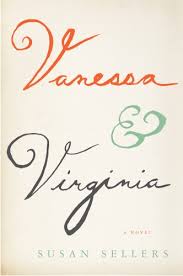 Vanessa & Virginia
Vanessa & Virginia
by Susan Sellers
Houghton Mifflin Harcourt. 213 pages, $23.
VANESSA & VIRGINIA is a short, imaginative novel of two sisters, Vanessa and Virginia Stephen, better known as the artist Vanessa Bell and the writer Virginia Woolf. Written from Vanessa’s perspective, it follows the two from childhood, depicting the tightly knit yet complex relationship between them through Virginia’s suicide in 1941 and into Vanessa’s old age. Author Susan Sellers, a professor of English at St. Andrews University, has used research from other scholars, including Hermione Lee’s biography of Virginia Woolf, to produce a faithful rendering of these two unconventional, highly creative women.
One cannot read this novel without thinking of Virginia’s work, especially To The Lighthouse. For instance, in a scene from their youth on holiday in Cornwall, Virginia tells her siblings, in a manner strongly resembling Mr. Ramsay, “There’ll be no going to the lighthouse tomorrow. It’s forecast rain.” And Vanessa’s memory of her mother wrapping her shawl around her brother Thoby’s sheep skull to calm the young Virginia’s fears is reminiscent of Mrs. Ramsay’s action for her own children. The sisters have a symbiotic relationship: Vanessa is inspired by Virginia’s modeling of the Ramsays after their own parents, as Virginia’s stream-of-consciousness writing style is influenced by both Vanessa’s paintings and the new ideas about art discussed by her friends in the Bloomsbury Group.
Vanessa is at the heart of Vanessa & Virginia, however, and one of the novel’s main concerns is the way in which Vanessa moves from the stilted, stultifying realm of Victorian morality to the modern world of open marriages and bisexuality. She marries Clive Bell and has two boys with him, yet the free, unabashed sexuality she enjoys quickly evaporates, resulting in their leading separate lives. Vanessa first becomes involved with the art critic Roger Fry, but her longest and most complicated relationship is with the painter Duncan Grant. They have a daughter together, but Duncan soon takes male lovers, including the young David Garnett, who will eventually marry her daughter Angelica. The compromises Vanessa makes to preserve her relationships with these men are disheartening to read about, particularly when, at Duncan’s urging, she writes a letter inviting David to live with them. She raises her three children, though, and diligently works on her paintings, many of which are described in this novel. Watching the process of artistic creation is fascinating, as are Vanessa’s sometimes cutting judgments of her own work.
The novel also depicts Virginia’s struggles with mental illness, which would eventually lead to her suicide. Her drastic mood swings and deep depression were triggered by traumatic events in her life, such as the death of both her parents. The sexual abuse she suffered at the hands of her half-brother George exacerbated her condition, and the novel briefly dramatizes this act in one horrifying scene. Even without the burden of illness, though, Virginia does not come across here as a particularly likable person. She is jealous and petty, envious of her sister’s marriage to Clive while she remains single. She models the title character in Orlando after her lover Vita Sackville-West, while describing her to Vanessa as “aristocratic, arrogant, and dressed like a parakeet.” She can also be a great comfort when necessary, such as when Vanessa collapses at her sister’s home on learning of Roger’s death, and Virginia calms her by telling her the story of Persephone’s abduction and marriage to Hades. The novel demonstrates the relationship between two talented sisters, at times bitter rivals, but at other times closer than husband and wife.
Charles Green is a writer based in Annapolis, Maryland.





